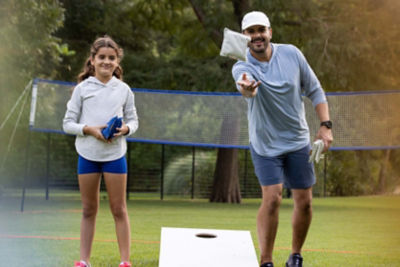How to Play Spikeball
Get the party started by spiking some fun into your next gathering with Spikeball. Learn the basic ins and outs of this backyard game with help from these Pro Tips.

The game of Spikeball (also known as Roundnet) is anything but square. Growing in popularity as both a competitive sport and a casual activity, it can energize your next tailgate, cookout or beach outing.
Spikeball’s not your average yard game. Players must tap into their agility and athleticism to use their entire body to outmaneuver opponents and spike a ball on a trampoline-type net in order to score points. Combining elements of foursquare and volleyball, Spikeball is guaranteed to serve up a good time. To enjoy the game, here’s everything you need to know, from equipment to rules and regulations.
SPIKEBALL SETUP
Before you can dive right into playing Spikeball, you’re going to need to make sure you have the right equipment. You can usually find everything you need in one convenient set, but there are two key elements:
- Net – In Spikeball, everything revolves around the net, which acts as the target that players use to score, as well as creating the area in which players line up to begin the game. Spikeball nets are roughly the size of a hula hoop.
You will have to assemble your net. Most sets come with removable plastic rim pieces that fit into five separate legs. Once the rim is assembled, clip the net into four varying points on the inside of the rim in order to make it easier to fasten the rest. After the net is secured, it should be tight enough that the balls bounce right off.
- Balls – The average ball in Spikeball is rubbery, yellow and about 12" in circumference — about the size of a grapefruit. They are filled with air and are light. They often have imprints for a look similar to that of a small volleyball. They will likely need to be inflated before playing, so a ball pump or gauge may be useful if you want to ensure you’re playing at tournament standards. Keep in mind that the more air you pump into the ball, the harder it can be to control during play. If you’re a newcomer hoping for easier ball handling, then less is more.
ROUNDNET REGULATIONS
Spikeball most often features two teams consisting of two players each (although one-on-one and three-on-three versions of the sport are also played). Before starting, teammates will stand next to each other on one side of the net facing their opponents. The game begins with a “serve,” which in the world of Spikeball involves spiking the ball down at the net and having it spring back at the opposition. A serve may be ineligible if the ball goes higher than the receiver’s raised hands.
You can determine who serves first in any way you choose, but the team that’s not serving must stand away from the net before the serve. After the serve, the game turns into an exciting 360-degree playing field.
When the ball is in play, the team with possession will have up to three touches to corral it before they have to spike it back toward the other team. Players can use any part of their body to hit the ball, but they cannot hit it twice in a row. Whoever has possession must either bump the ball back to their teammate or spike it on the net.
While there are no perimeters to the game after a serve, there are still some things that are considered out of bounds. If a defensive player interferes with the team going for the ball, it is called a “hinder” and the play will restart. However, if an offensive player claims to be “hindered” without a legitimate reason, the opposing team is awarded one point.
Other infractions include a defensive player attempting to hit the ball before the receiving team’s turn is completed and any shot by an offensive player that hits the net and ricochets back to hit them or their teammate.
SCORING
Ultimately the object of the game and the most common way to score points is to spike the ball in such a way that the other team can’t return it within three hits. However, there are a few other ways scoring can occur. The defending team will earn a point if someone on offense hits the ball twice in a row, double bounces on the net or hits the rim of the net. In each case, the team who earned the point will serve the next play.
Most games of Spikeball are typically played rally-style until a team reaches 21 points, but feel free to keep playing to whatever score you want. Similar to volleyball, teams are often required to win by two points. Since the goal of the game is to be the first to the agreed upon score, there really isn’t any need for a tiebreaker.
Now that you’re familiar with the basics of Spikeball, you and your friends can add a new and challenging game your outdoor rotation. And unlike other favorites, in this game, spiking the ball won’t stop the clock on your fun.








